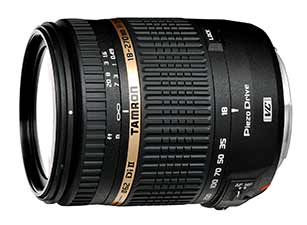 1. An All-In-One Lens vs. Multiple Lenses.
1. An All-In-One Lens vs. Multiple Lenses.
Most casual photographers don’t need multiple lenses, especially when they have the choice of the Tamron AF 18–270mm f/3.5–6.3 Di II VC LD Aspherical (IF) MACRO zoom lens. Tamron is known as the kingmaker of super-zoom lenses and this lens certainly wears a crown, as a nearly perfect all-in-one lens for the amateur.
2. Size and Weight.
Casual photographers often make the mistake of thinking that a big, heavy lens is better and makes some kind of statement about their photography skills. Amateurs usually learn the hard way that carrying a camera and large lens during an all-day family event, for example, is not a smart idea. Hobbyists will also forget about buying a lens that creates a comfortable balance point when combined with an existing camera body. The Tamron lens is a better-balanced package with larger DSLRs.
Tamron understands all these issues, even if its casual photography customers do not, which is why the company designed the 18–270mm to be a small, light and very portable lens. It weighs only 15.9 ounces and is just four inches in length.
3. Easy-to-Reach Lenses Switches.
Another error in thinking is that the bigger lens companies always make better products. In some cases, they do; but, once again, Tamron was thinking of its customers, placing three switches on the lens: auto-focus, Tamron’s Vibration Compensation and a zoom lock (at 18mm). These switches are definitely easier to use because they are larger than the equivalent switches on Canon and Nikon lenses.
4. The Importance of Optical Stabilization.
Casual photographers don’t have the same experience as pros when it comes to hand holding their cameras and knowing how to keep them steady. A built-in optical stabilization system (OS) is, therefore, an essential feature of any lens an amateur may buy. The Tamron 18-270mm Di II VC PZD f/3.5–6.3 includes the company’s Vibration Compensation technology, which a lens of this size and slow speed must have. Tamron’s OS corrects vibration at least 3 stops better.
5. Image Quality in Common Shooting Range.
Casual photographers are often defined as those who only use a limited range of focal lengths on a super-zoom lens like the Tamron AF 18–270mm f/3.5–6.3. Generally, it’s only the semi-pros and pros that have reasons to shoot at the low and high end of the focal length (18mm and 270mm on this lens).
The amateur needs a super-zoom lens that will deliver excellent image quality in the normal to short telephoto range, 50mm to 150mm, for example, which is exactly what the Tamron lens provides.
6. Too Concerned With Looks.
Casual photographers will make the mistake of valuing looks over functionality. Honestly, the look of Tamron lenses is not the most appealing, but don’t be deceived by the 18–270mm’s unattractive styling. The metal mount and lightweight, but durable, plastic parts are comparable to its competitors. The hand and fingers grip the wide zoom ring comfortably and the focus ring is within easy reach to the front of the lens. As with many super-zoom lenses, the Tamron 18–270mm has “double-trombone” mechanics, which almost doubles its length. Despite that liberal extension, it seems no bigger or heavier than other manufacturers’ 18–200mm zooms.
7. Zoom Creep.
Zoom creep is another factor related to carrying this lens for an extended period of time; and amateurs will forget to examine any lens they are thinking of purchasing for this problem.
Zoom creep often occurs while carrying a super-zoom lens nose to the ground. The front of the lens is so heavy (with its large glass elements) that gravity takes effect and causes the lens to extend. Super-zoom lenses will also creep when reduced to their shortest lengths and inverted, with the heavy end above the camera.
Although the Tamron 18–270mm super-zoom lens does have some zoom creep, it has tested at the bottom of the zoom-creep range. It is likely only to affect certain types of photographers and shooting situations.
8. Balanced Product.
Casual photographers mistakenly decide they need a super-zoom lens with features and capabilities that are all rated excellent. Only pros require extreme specifications and they must pay a much higher price for them. A primary strength of the Tamron 18–270mm is that the company was able to engineer the right balance of a much longer telephoto distance (with the 15x focal length range) and image quality. This is a feature Tamron’s competitors haven’t yet duplicated. Just as attractive for the consumer is that so much functionality was packed into a lens of greater focal length, but is essentially no larger or heavier than its competitors.
9. Value for Money.
A major blunder of many casual photographers is failing to making an accurate value comparison when shopping for a super-zoom lens.
The Tamron lens has a 15x zoom ratio, so its 18–270mm is the equivalent of 28mm wide-angle to 420mm telephoto in the traditional 35-mm format. The Tamron AF 18–270mm f/3.5–6.3 can be purchased for approximately $649.
The comparable lens from Nikon, 18–200mm f/3.5–5.6G IF-ED AF-S VR II DX, is an equivalent 27mm to 300mm, and is priced at approximately $850.
Canon’s EF-S 18–200mm f/3.5–5.6 IS offers 20mm to 300mm equivalent and is approximately $700.
The Tamron AF 18–270mm f/3.5–6.3 is clearly designed and priced for the casual photographers. The Nikon and Canon equivalent models for semi-pros and pros.
Your feedback is important to thousands of PhotographyTalk.com fans and us. If this article is helpful, then please click the Like and Re-Tweet buttons at the top left of this article.
